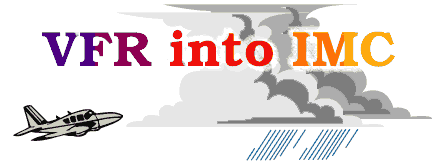
Instrument Meteorological
Conditions (IMC) manage to sneak up on many pilots. Two ASRS reports
of unintentional brushes with IMC show how easily a pilot can be caught
by surprise. The first reporter, a low-time private pilot, sought ATC
assistance for the IMC dilemma, and unwittingly became the recipient
of an unwanted IFR clearance.
- My departure
was at noon instead of [early morning]. I did not call for an update
on the weather, and departed with my briefing from the morning. I
had my head down trying to program a GPS which had been lent to me,
and I got stuck in a cloud with poor visibility.
I tried a 180-degree turn, but it did not seem to work, so I pitched
up and started climbing. I contacted Center from which I was receiving
flight following, and asked for a clearance to XYZ. They asked if
I was IFR able and if the plane was. I said affirmative, thinking
that I had training in IFR upon acquiring my Private [rating], and
the plane had instruments with which I could fly IFR if I had to in
an emergency situation. Then the controller gave a clearance and,
at the time, I did not understand that I was indeed receiving an IFR
clearance.
I told the controller I did not want to fly IFR and wanted to fly
VFR. He stated, "You want to make it to XYZ, but it's IFR in
XYZ." I repeated that I did not want to fly IFR. [The
controller then vectored me to the closest VFR airport.] When I landed
there it was fine VFR.
The controller did an admirable
job of getting the pilot out of the clouds. An up-to-date weather briefing
prior to the delayed departure might have encouraged the reporter to
choose a destination more likely to remain VFR, or alternatively, to
stay on the ground. Then, when stuck in IMC, this non-IFR-rated pilot
would have received better ATC service by immediately admitting the
lack of an instrument rating.
The next reporter hoped to
avoid the forecast midday thunderstorms by departing in the early morning.
Alas, the thunderstorms didn't read the forecast.
- I called
FSS to get a weather briefing for VFR flight. The forecast called
for a cold front to be coming in quite fast and weather to get much
worse with thunderstorms developing by midday. I climbed to 12,500
feet, and noted a solid overcast layer at 11,000 feet [along my route
of flight]. I contacted Center to request flight following, and checked
Flight Watch to confirm there were adequate broken and scattered holes
to descend safely close to my destination.
The solid overcast layer began rising and quickly turned into cumulonimbus
clouds, forcing me to climb. As I reached 14,500 feet, the clouds
were developing very fast and rising all around me...In a very short
time I was close to 18,000 feet. Center asked me if I was IFR capable,
and I stated negative. They asked me if I had supplemental oxygen,
and I stated negative. Soon I was at 19,700 feet, and Center said
we have to get you back down to 12,500 feet. I was given a heading
and was told to chop the power and keep wings level with a 500-600-foot-per-minute
descent down through the clouds with reference to my artificial horizon.
So I did as I was told...and I broke out of the clouds at 13,000 feet.
I had a very bad headache and was disoriented. I was handed over to
Tower [and landed uneventfully].
With 20/20 hindsight, I see that the rising cloud tops were extremely
clear, strong STOP signs. I should have turned around when I confirmed
the overcast layer was ascending.
Taking the conservative route
-- doing a 180 degree turn -- is usually the better bet when facing
IMC. Kudos to the sharp Center Controller for safely resolving this
pilot's emergency.
Not
Good Form
In our next report, the commuter
crew were flying in VMC on an IFR flight plan, but both were distracted
from their flying and monitoring duties by Customs forms that could
have waited until the flight had landed.
- We were
given a descent clearance to 14,000 feet. It was the First Officer's
leg to fly and I was filling out our crew declaration Customs form.
I noticed that the First Officer was also filling out the Customs
form, so I occasionally looked up to monitor our flight situation.
The autopilot was descending initially, but had somehow disengaged
without us knowing why. The autopilot warning announcing disengagement
only occurs below 2,500 feet AGL. Because our descent was shallow
and we were filling out our Customs forms, no one noticed we had descended
through our assigned altitude until we were 500 feet below it. It
was a light traffic day...and no traffic was on TCAS II. Center didn't
mention the altitude deviation. In the future, I will pay closer attention
to monitoring the autopilot...and I will supervise my First Officer
more closely during autoflight.
The Captain filed this report
to document the uncommanded disengagement of the autopilot. However,
automation -- the "Magic" -- is never a substitute for flying
the aircraft. The reminder for all is that the crew's first priority
should always be on flying duties, including altitude callouts, checklists,
and traffic watch. Ground duties should be saved and performed on the
ground.

Many pilots would prefer
to avoid dealing with aircraft paperwork and logbooks. But, as the following
report describes, a General Aviation pilot's look into old paperwork
yielded a very serious discrepancy.
- We were
flying on a long cross-country and had to divert and over-night due
to weather. We decided to spend some time reviewing the aircraft logs,
manuals, 337s [Major Repairs or Alterations], etc. Flying is a technical
hobby for us, so we spend a lot more than most pilots just talking
about aircraft documents and the like. While looking through some
recent maintenance records, we found an invoice for a fuel bladder
replacement showing a standard range fuel tank. The flight manuals,
the equipment list, and all documents we could find listed long-range
tanks. We had always flight-planned for long-range tanks based on
those documents.
A check on the serial number with the manufacturer verified it had
been built with standard tanks. For at least 15 years, this plane
was flown under the belief that it had long-range tanks. Somewhere
down the line, someone made the assumption that the plane had long-range
tanks, and wrote it down without looking at a written document to
confirm the fact. [Then] it was spread...through all the documents
associated with the plane.
The longest flight I ever made in this plane was in MVFR/IMC at night
[over mountainous terrain]. We planned 5.25 flight time, plus 2.25
reserve based on long-range tanks. Flight time was 5.5 hours. We took
on 66 gallons of fuel. Usable fuel is 65 gallons on standard tanks.
I have found this problem of incorrect data before. During installation
of avionics in a plane I owned, someone subtracted the weight of two
radios rather than adding them into the weight-and-balance. The total
difference was 60 lb. (no major impact in that airplane). The error
was made in 1965 and carried through every weight-and-balance up to
1995 when the plane was reweighed. I questioned why [the new aircraft
weight] didn't match the old weight-and-balance. Recalculating every
weight-and-balance found the discrepancy.
Dry and dusty as they may
be, aircraft records often contain a wealth of interesting information
-- and possibly some discrepancies, too.
An air carrier Captain provides
a report about a piece of paper that is a frequent source of confusion
to pilots -- the aircraft MEL (Minimum Equipment List):
- I incorrectly
interpreted the leading edge flap/slat position indicator light procedure
in the MEL. I deferred an item that evidently was not deferrable.
I had conferred with Dispatch and the other pilot, and we were all
in agreement as to our ability to defer the item. I think the problem
was caused primarily by the wording of the MEL title and the unclear
verbiage in that section. I should have read it more carefully and
called Maintenance on the radio for their interpretation.
Since MELs are generally
not written in "plain English," repeated readings may be required
for complete understanding of their limitations and allowances. In addition,
direct contact with the Maintenance Control Department may provide clarification
that a dispatcher or other pilot cannot offer.
The Color
of Caution
Perhaps the most commonly
misread piece of paper is the aircraft checklist. This report of a checklist
incident was submitted by an air carrier Captain.
- We were
taxiing out for takeoff. The Second Officer read the taxi checklist
and the First Officer responded. One item is flaps [looking for a
green light]. This was responded to correctly. Prior to takeoff, the
same challenge was answered again. An FAA inspector on our jumpseat
stopped the checklist at this time and told us the light was not green,
but amber. We returned to the gate. The flight was delayed for 24
hours for a flap problem.
All three crew members missed this call. The amber light is associated
with landing, not takeoff. This problem could have caused a very interesting
takeoff.
This incident could have
been avoided by more careful consideration of each individual checklist
item, rather than rote responses to the familiar pre-takeoff agenda.
Stray
Blue Sheet
A
corporate pilot reports that one more bit of stray paper, a recent
issue of CALLBACK, made an impression. Apparently not quite a
big enough impression...
- I
was just reading in the last CALLBACK about low altimeter settings.
I thought that could never happen to me. Well, guess what? [As
we were climbing out] Center had cleared us to FL270. They asked
our altitude, as they showed us high. Sure enough, our altimeter
was set on 28.92. The previous crew had had a setting of 28.96.
I had not even looked at the first two numbers. We had some
other distractions, but that is no excuse. Never say never.
The
last two numbers of the altimeter setting were so close that it
didn't register with the reporter that the first two numbers were
a problem -- the 28 should have been a 29.



